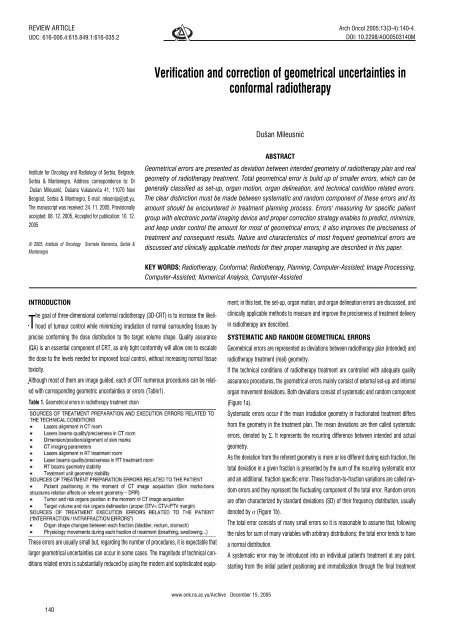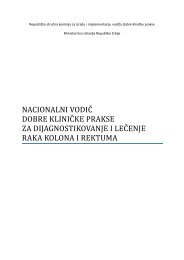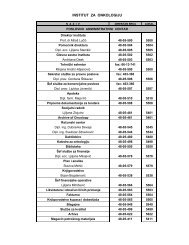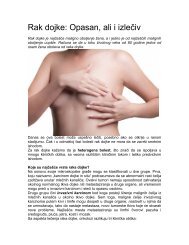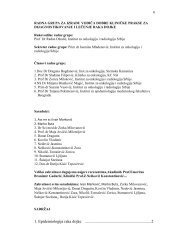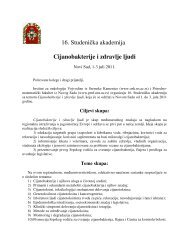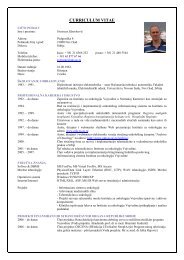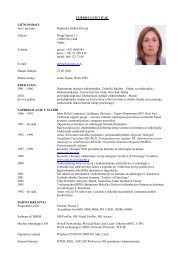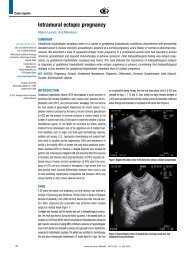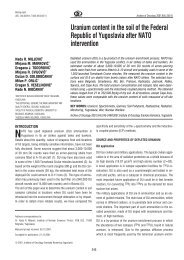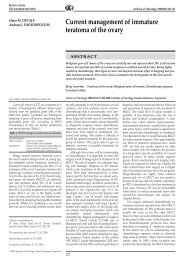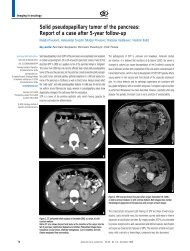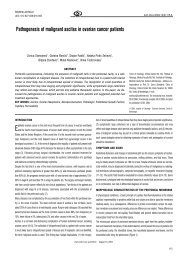Verification and correction of geometrical uncertainties in ... - doiSerbia
Verification and correction of geometrical uncertainties in ... - doiSerbia
Verification and correction of geometrical uncertainties in ... - doiSerbia
Create successful ePaper yourself
Turn your PDF publications into a flip-book with our unique Google optimized e-Paper software.
REVIEW ARTICLE<br />
UDC: 616-006.4:615.849.1:616-035.2<br />
Arch Oncol 2005;13(3-4):140-4.<br />
DOI: 10.2298/AOO0503140M<br />
<strong>Verification</strong> <strong>and</strong> <strong>correction</strong> <strong>of</strong> <strong>geometrical</strong> <strong>uncerta<strong>in</strong>ties</strong> <strong>in</strong><br />
conformal radiotherapy<br />
Du¹an Mileusniæ<br />
ABSTRACT<br />
Institute for Oncology <strong>and</strong> Radiology <strong>of</strong> Serbia, Belgrade,<br />
Serbia & Montenegro, Address correspondence to: Dr<br />
.Du¹an Mileusniæ, Du¹ana Vukasoviæa 41, 11070 Novi<br />
Beograd, Serbia & Montnegro, E-mail: mksenija@ptt.yu,<br />
The manuscript was received: 24. 11. 2005, Provisionally<br />
accepted: 08. 12. 2005, Accepted for publication: 10. 12.<br />
2005<br />
© 2005, Institute <strong>of</strong> Oncology Sremska Kamenica, Serbia &<br />
Montenegro<br />
Geometrical errors are presented as deviation between <strong>in</strong>tended geometry <strong>of</strong> radiotherapy plan <strong>and</strong> real<br />
geometry <strong>of</strong> radiotherapy treatment. Total <strong>geometrical</strong> error is build up <strong>of</strong> smaller errors, which can be<br />
generally classified as set-up, organ motion, organ del<strong>in</strong>eation, <strong>and</strong> technical condition related errors.<br />
The clear dist<strong>in</strong>ction must be made between systematic <strong>and</strong> r<strong>and</strong>om component <strong>of</strong> these errors <strong>and</strong> its<br />
amount should be encountered <strong>in</strong> treatment plann<strong>in</strong>g process. Errors' measur<strong>in</strong>g for specific patient<br />
group with electronic portal imag<strong>in</strong>g device <strong>and</strong> proper <strong>correction</strong> strategy enables to predict, m<strong>in</strong>imize,<br />
<strong>and</strong> keep under control the amount for most <strong>of</strong> <strong>geometrical</strong> errors; it also improves the preciseness <strong>of</strong><br />
treatment <strong>and</strong> consequent results. Nature <strong>and</strong> characteristics <strong>of</strong> most frequent <strong>geometrical</strong> errors are<br />
discussed <strong>and</strong> cl<strong>in</strong>ically applicable methods for their proper manag<strong>in</strong>g are described <strong>in</strong> this paper.<br />
KEY WORDS: Radiotherapy, Conformal; Radiotherapy, Plann<strong>in</strong>g, Computer-Assisted; Image Process<strong>in</strong>g,<br />
Computer-Assisted; Numerical Analysis, Computer-Assisted<br />
INTRODUCTION<br />
The goal <strong>of</strong> three-dimensional conformal radiotherapy (3D-CRT) is to <strong>in</strong>crease the likelihood<br />
<strong>of</strong> tumour control while m<strong>in</strong>imiz<strong>in</strong>g irradiation <strong>of</strong> normal surround<strong>in</strong>g tissues by<br />
precise conform<strong>in</strong>g the dose distribution to the target volume shape. Quality assurance<br />
(QA) is an essential component <strong>of</strong> CRT, as only tight conformity will allow one to escalate<br />
the dose to the levels needed for improved local control, without <strong>in</strong>creas<strong>in</strong>g normal tissue<br />
toxicity.<br />
Although most <strong>of</strong> them are image guided, each <strong>of</strong> CRT numerous procedures can be related<br />
with correspond<strong>in</strong>g geometric <strong>uncerta<strong>in</strong>ties</strong> or errors (Table1).<br />
Table 1. Geometrical errors <strong>in</strong> radiotherapy treatment cha<strong>in</strong><br />
These errors are usually small but, regard<strong>in</strong>g the number <strong>of</strong> procedures, it is expectable that<br />
larger <strong>geometrical</strong> <strong>uncerta<strong>in</strong>ties</strong> can occur <strong>in</strong> some cases. The magnitude <strong>of</strong> technical conditions<br />
related errors is substantially reduced by us<strong>in</strong>g the modern <strong>and</strong> sophisticated equipment;<br />
<strong>in</strong> this text, the set-up, organ motion, <strong>and</strong> organ del<strong>in</strong>eation errors are discussed, <strong>and</strong><br />
cl<strong>in</strong>ically applicable methods to measure <strong>and</strong> improve the preciseness <strong>of</strong> treatment delivery<br />
<strong>in</strong> radiotherapy are described.<br />
SYSTEMATIC AND RANDOM GEOMETRICAL ERRORS<br />
Geometrical errors are represented as deviations between radiotherapy plan (<strong>in</strong>tended) <strong>and</strong><br />
radiotherapy treatment (real) geometry.<br />
If the technical conditions <strong>of</strong> radiotherapy treatment are controlled with adequate quality<br />
assurance procedures, the <strong>geometrical</strong> errors ma<strong>in</strong>ly consist <strong>of</strong> external set-up <strong>and</strong> <strong>in</strong>ternal<br />
organ movement deviations. Both deviations consist <strong>of</strong> systematic <strong>and</strong> r<strong>and</strong>om component<br />
(Figure 1a).<br />
Systematic errors occur if the mean irradiation geometry <strong>in</strong> fractionated treatment differs<br />
from the geometry <strong>in</strong> the treatment plan. The mean deviations are then called systematic<br />
errors, denoted by S. It represents the recurr<strong>in</strong>g difference between <strong>in</strong>tended <strong>and</strong> actual<br />
geometry.<br />
As the deviation from the referent geometry is more or les different dur<strong>in</strong>g each fraction, the<br />
total deviation <strong>in</strong> a given fraction is presented by the sum <strong>of</strong> the recurr<strong>in</strong>g systematic error<br />
<strong>and</strong> an additional, fraction specific error. These fraction-to-fraction variations are called r<strong>and</strong>om<br />
errors <strong>and</strong> they represent the fluctuat<strong>in</strong>g component <strong>of</strong> the total error. R<strong>and</strong>om errors<br />
are <strong>of</strong>ten characterized by st<strong>and</strong>ard deviations (SD) <strong>of</strong> their frequency distribution, usually<br />
denoted by s (Figure 1b).<br />
The total error consists <strong>of</strong> many small errors so it is reasonable to assume that, follow<strong>in</strong>g<br />
the rules for sum <strong>of</strong> many variables with arbitrary distributions; the total error tends to have<br />
a normal distribution.<br />
A systematic error may be <strong>in</strong>troduced <strong>in</strong>to an <strong>in</strong>dividual patient's treatment at any po<strong>in</strong>t,<br />
start<strong>in</strong>g from the <strong>in</strong>itial patient position<strong>in</strong>g <strong>and</strong> immobilization through the f<strong>in</strong>al treatment<br />
www.onk.ns.ac.yu/Archive December 15, 2005<br />
140
Geometrical <strong>uncerta<strong>in</strong>ties</strong> <strong>in</strong> conformal radiotherapy<br />
delivery. Once <strong>in</strong>troduced, this error is fixed, <strong>and</strong> if not corrected, will lead to a consistent<br />
discrepancy between <strong>in</strong>tended <strong>and</strong> actual target coverage (1).<br />
R<strong>and</strong>om errors are ma<strong>in</strong>ly <strong>in</strong>troduced dur<strong>in</strong>g the treatment execution process <strong>and</strong> will therefore<br />
vary between fractions.<br />
Both components <strong>of</strong> total <strong>geometrical</strong> error (external - set-up deviations <strong>and</strong> <strong>in</strong>ternal - organ<br />
movement) should be accounted <strong>in</strong> the treatment plann<strong>in</strong>g, but for <strong>in</strong>dividual patient they<br />
are not predictable.<br />
Measured for an <strong>in</strong>dividual patient, both systematic <strong>and</strong> r<strong>and</strong>om errors can be fully<br />
assessed after completion <strong>of</strong> all treatment fractions (Figure 1a,b). By their measur<strong>in</strong>g before<br />
the end <strong>of</strong> the treatment by means <strong>of</strong> electronic portal imag<strong>in</strong>g device (EPID), it is possible<br />
to partially correct systematic error by apply<strong>in</strong>g the <strong>of</strong>-l<strong>in</strong>e or the on-l<strong>in</strong>e <strong>correction</strong> protocol<br />
<strong>and</strong> to correct r<strong>and</strong>om error by us<strong>in</strong>g the on-l<strong>in</strong>e protocol.<br />
Figure 1. Figure 1. Set-up error measured for <strong>in</strong>dividual patient dur<strong>in</strong>g the fractionated RT treatment<br />
1a. Measured set-up errors for 20 fractions <strong>of</strong> specific patient, <strong>in</strong> two directions (x, y). Each square<br />
represent the set-up error <strong>of</strong> particular fraction. The solid circle <strong>in</strong>dicates the mean <strong>of</strong> these errors <strong>and</strong><br />
the correspond<strong>in</strong>g displacement (arrow `s`) is the systematic set-up error <strong>of</strong> this patient. The total<br />
set-up error <strong>of</strong> any fraction (the greyed square <strong>and</strong> correspond<strong>in</strong>g arrow `t`) is the sum <strong>of</strong> the systematic<br />
error <strong>and</strong> the r<strong>and</strong>om set-up error (arrow `r`) <strong>of</strong> that fraction, b. R<strong>and</strong>om set-up errors (s)<br />
described by st<strong>and</strong>ard deviation (SD) <strong>of</strong> their frequency distribution.<br />
Figure 2. Set-up systematic errors measured for patient specific group<br />
2a. Systematic set-up errors for 10 patients, represented by arrows (an asterisk marks the systematic<br />
error <strong>of</strong> the patient <strong>in</strong> Fig. 1a), b. Frequency distribution <strong>of</strong> systematic set-up errors (solid l<strong>in</strong>e),<br />
measured <strong>in</strong> the patient specific group <strong>of</strong> Fig. 1b.The mean <strong>of</strong> this distribution is <strong>in</strong>dicated by the<br />
vertical l<strong>in</strong>e, which is displaced by some amount from 0, the SD equals S.<br />
However, <strong>geometrical</strong> errors components can be measured <strong>in</strong> a group <strong>of</strong> previously treated<br />
similar patients, <strong>and</strong> described us<strong>in</strong>g st<strong>and</strong>ard deviations (Figure 2 a, b). Once the typical<br />
values for specific group <strong>of</strong> patient are known they can be used to establish <strong>in</strong>stitutional<br />
<strong>correction</strong> protocols <strong>and</strong> <strong>in</strong>cluded <strong>in</strong> the treatment plann<strong>in</strong>g <strong>in</strong> order to def<strong>in</strong>e plann<strong>in</strong>g target<br />
volume (PTV) (2).<br />
ELECTRONIC PORTAL IMAGING DEVICE (EPID)<br />
In recent years, EPIDs have a wide cl<strong>in</strong>ical use for detection <strong>and</strong> management <strong>of</strong> <strong>geometrical</strong><br />
errors dur<strong>in</strong>g radiotherapy treatment. The EPID is attached to the LINAC gantry <strong>and</strong> it<br />
may <strong>in</strong>tercept the exit<strong>in</strong>g photon beams at all gantry angles. EPID uses a fluorescent screen<br />
to convert the high-energy photons <strong>of</strong> the treatment beam <strong>in</strong>to visible light. The light is captured<br />
by a CCD camera or amorphous silicon flat panel detector <strong>and</strong> the ensu<strong>in</strong>g images are<br />
processed <strong>and</strong> analysed by dedicated s<strong>of</strong>tware (Figure 3).<br />
Figure 3. External beam radiotherapy configuration with EPID<br />
The first generation <strong>of</strong> camera-based EPIDs had a number <strong>of</strong> limitations mostly related to<br />
image quality while the current commercially available take advantage <strong>of</strong> flat panel display<br />
technology, provid<strong>in</strong>g faster acquisition <strong>and</strong> superior image quality. In comb<strong>in</strong>ation with a<br />
modern digital accelerator fitted with multileaf collimator, field set-up <strong>and</strong> image acquisition<br />
can be done remotely <strong>and</strong> displayed <strong>in</strong> seconds, obviat<strong>in</strong>g the need to re-enter the treatment<br />
room each time. This allows more frequent treatment verification, or to acquire a series <strong>of</strong><br />
images dur<strong>in</strong>g a s<strong>in</strong>gle treatment for patient movement estimation. Another powerful feature<br />
is that the images are <strong>in</strong> digital form, which allows application <strong>of</strong> s<strong>of</strong>tware tools for process<strong>in</strong>g<br />
to extract <strong>in</strong>formation relevant to treatment verification <strong>and</strong> their manag<strong>in</strong>g by picture<br />
archiv<strong>in</strong>g <strong>and</strong> communication systems (PACS) specially designed for radiotherapy.<br />
EPID is a primary tool for quality assurance <strong>in</strong> radiation delivery. To verify patient position<strong>in</strong>g<br />
the portal image <strong>of</strong> the first treatment is compared with the correspond<strong>in</strong>g reference<br />
image which can be digitised simulator image, but the digitally reconstructed radiography<br />
(DRR), image generated by treatment plann<strong>in</strong>g system from the CT data set is most <strong>of</strong>ten<br />
used for this purpose. Various algorithms have been developed to enable computerized<br />
comparison <strong>of</strong> images for detection <strong>of</strong> field placement errors. This is usually accomplished<br />
<strong>in</strong> several steps:<br />
1. Information about the position <strong>of</strong> the patient anatomy (bony structures) <strong>and</strong> radiation field<br />
is extracted from both portal <strong>and</strong> reference images.<br />
2. A common reference frame for both images is established by registration <strong>of</strong> the radiation<br />
fields.<br />
3. Set-up error is determ<strong>in</strong>ed by register<strong>in</strong>g the patient anatomy <strong>in</strong> both images, then measur<strong>in</strong>g<br />
the result<strong>in</strong>g displacement between the portal <strong>and</strong> reference radiation field edges.<br />
Three most common methods <strong>of</strong> <strong>in</strong>teractive, or manual, image registrations are:<br />
1. The draw<strong>in</strong>g curves technique ("template technique"): by track<strong>in</strong>g the outl<strong>in</strong>es <strong>of</strong> bony<br />
l<strong>and</strong>marks on DRR, same pattern automatically appears on portal image. If the referent <strong>and</strong><br />
portal curves are misaligned <strong>in</strong> relation to the same bony l<strong>and</strong>marks, it <strong>in</strong>dicates the patient<br />
set-up misalignment, which can be corrected accord<strong>in</strong>g to calculation <strong>of</strong> deviation.<br />
2. Po<strong>in</strong>t pair registration: by digitis<strong>in</strong>g the po<strong>in</strong>t over the recognizable bony l<strong>and</strong>mark <strong>in</strong> the<br />
reference image <strong>and</strong> identify<strong>in</strong>g the relations between correspond<strong>in</strong>g po<strong>in</strong>t position <strong>and</strong><br />
bony l<strong>and</strong>mark <strong>in</strong> portal image - if necessary, deviation calculation <strong>and</strong> set up <strong>correction</strong> are<br />
possible.<br />
3. Automatic (s<strong>of</strong>tware) reference <strong>and</strong> portal image match<strong>in</strong>g: reference <strong>and</strong> port image are<br />
automatically overlapped <strong>and</strong> <strong>in</strong> case <strong>of</strong> any apparent shift <strong>in</strong> the images position, the<br />
patient misalignment is <strong>in</strong>dicated.<br />
To def<strong>in</strong>e the position<strong>in</strong>g (<strong>and</strong> set up error) <strong>in</strong> all three planes it is necessary to provide two<br />
sets <strong>of</strong> reference-portal images. Images with 0¼ or 180¼ gantry angle provide position<strong>in</strong>g<br />
<strong>in</strong>formation <strong>in</strong> the lateral <strong>and</strong> longitud<strong>in</strong>al axes, while these with 90¼ or 270¼ gantry angle<br />
provide position<strong>in</strong>g <strong>in</strong>formation <strong>in</strong> the longitud<strong>in</strong>al <strong>and</strong> vertical axes.<br />
www.onk.ns.ac.yu/Archive December 15, 2005<br />
141
Mileusniæ D.<br />
Portal images are part <strong>of</strong> the overall quality assurance program for ongo<strong>in</strong>g verification <strong>of</strong><br />
treatment accuracy. They can reveal errors <strong>in</strong> the patient set-up position, field size <strong>and</strong> orientation<br />
or placement <strong>and</strong> shap<strong>in</strong>g <strong>of</strong> MLC (or shield<strong>in</strong>g blocks). Portal images should be<br />
estimated; discrepancies should be <strong>in</strong>vestigated <strong>and</strong> corrected accord<strong>in</strong>g to cl<strong>in</strong>ical criteria<br />
<strong>and</strong> established protocols <strong>and</strong> f<strong>in</strong>ally approved <strong>and</strong> signed (electronically via radiotherapy<br />
PACS).<br />
In recent years, a number <strong>of</strong> patient position monitor<strong>in</strong>g systems have been developed.<br />
Some <strong>of</strong> them use one or more image detectors together <strong>in</strong> comb<strong>in</strong>ation with diagnostic x-<br />
ray sources <strong>in</strong> the treatment room. Diagnostic quality radiographs facilitate automatic image<br />
registration <strong>and</strong> beam alignment just before treatment or <strong>in</strong> real time dur<strong>in</strong>g treatment (3).<br />
By the newest systems, it is also possible to obta<strong>in</strong> kilovoltage or megavoltage quality 3D<br />
treatment image set through cone beam image reconstruction. The source-detector pair<br />
moves around the patient to collect a set <strong>of</strong> 2D projection images, which are then processed<br />
with a cone-beam reconstruction algorithm to obta<strong>in</strong> a 3-D image set. After s<strong>of</strong>tware match<strong>in</strong>g<br />
with the 3D plan correspond<strong>in</strong>g volumes, it is possible to apply fully 3D set - <strong>of</strong>f calculation<br />
<strong>and</strong> on l<strong>in</strong>e set up <strong>correction</strong>.<br />
Except to set-up verification <strong>and</strong> <strong>correction</strong> procedures, EPIs can be used <strong>in</strong> transit dosimetry.<br />
This application requires that the <strong>in</strong>tensities measured <strong>in</strong> the EPI can be translated to the<br />
radiation dose imp<strong>in</strong>gent on the detector with a high accuracy. The resultant "portal dose<br />
images" can be used to verify the dose delivered to the patient (4).<br />
EPI thus comb<strong>in</strong>e <strong>in</strong>formation on geometry <strong>and</strong> dosimetry dur<strong>in</strong>g the actual treatment <strong>and</strong><br />
therefore yield an ideal tool for quality assurance <strong>and</strong> improvement <strong>of</strong> treatment delivery,<br />
particularly <strong>in</strong> conformal radiotherapy, where the dem<strong>and</strong>s on the set-up accuracy are high<br />
<strong>and</strong> technique <strong>of</strong> dose delivery may <strong>in</strong>volve complex dynamic processes.<br />
Correction <strong>of</strong> set-up errors - <strong>of</strong>f l<strong>in</strong>e <strong>and</strong> on l<strong>in</strong>e <strong>correction</strong> protocols<br />
Total set-up error consists <strong>of</strong> systematic (S set-up) <strong>and</strong> r<strong>and</strong>om component (s set-up).<br />
Systematic set-up error is affected by two groups <strong>of</strong> sub errors - S prescription parameters<br />
transfer (comb<strong>in</strong>es many systematic errors at around the 1 mm level, which have been subdivided<br />
<strong>in</strong>to imag<strong>in</strong>g geometry, treatment plann<strong>in</strong>g system <strong>and</strong> treatment mach<strong>in</strong>e geometry<br />
errors) <strong>and</strong> S set-up (related for some differences regard<strong>in</strong>g couch <strong>and</strong> immobilization<br />
device sag which may cause deformation <strong>of</strong> <strong>in</strong>ternal organs).<br />
All parts <strong>of</strong> systematic error can be corrected by alter<strong>in</strong>g the patient set-up for an amount<br />
based upon portal images measurements. This enables these systematic errors to be controlled<br />
with<strong>in</strong> def<strong>in</strong>ed tolerances. QA checks <strong>of</strong> all equipment <strong>in</strong>volved <strong>in</strong> the treatment<br />
process should be made regularly to ensure S transfer is ma<strong>in</strong>ta<strong>in</strong>ed with<strong>in</strong> acceptable limits.<br />
Couch <strong>and</strong> immobilization equipment compatibility between simulation <strong>and</strong> treatment<br />
mach<strong>in</strong>es is also very important.<br />
R<strong>and</strong>om set-up error gives <strong>in</strong>formation about the variation for patient set-up on a day-today<br />
basis. It is therefore a good <strong>in</strong>dicator for the ability <strong>of</strong> an <strong>in</strong>dividual technique to immobilize<br />
the patient <strong>in</strong> a reliably reproducible position. It will also be affected by treatment technique,<br />
staff experience, subjective <strong>in</strong>terpretation <strong>of</strong> set-up <strong>in</strong>structions <strong>and</strong> reference marks.<br />
R<strong>and</strong>om set-up deviations may be estimated by compar<strong>in</strong>g portal images aga<strong>in</strong>st a DRR<br />
reference image. Unless immediate (on-l<strong>in</strong>e) <strong>correction</strong> <strong>of</strong> daily set up error is performed,<br />
the best way to reduce s set-up is by improv<strong>in</strong>g immobilization <strong>and</strong> set-up reproducibility.<br />
EPI can be used as effective technique to measure <strong>and</strong> reduce set-up errors relative to the<br />
<strong>in</strong>tended set-up geometry. There are two different approaches to calculate <strong>and</strong> correct setup<br />
errors i.e., <strong>of</strong>f-l<strong>in</strong>e <strong>and</strong> on-l<strong>in</strong>e.<br />
In the on-l<strong>in</strong>e approach, an EPI is obta<strong>in</strong>ed us<strong>in</strong>g a small part <strong>of</strong> the fraction dose at the<br />
beg<strong>in</strong>n<strong>in</strong>g <strong>of</strong> each fraction, the total amount <strong>of</strong> daily fraction set-up deviation is measured<br />
<strong>and</strong> corrected immediately by adjust<strong>in</strong>g the couch position (while the patient rema<strong>in</strong>s on the<br />
treatment couch), after which the rema<strong>in</strong><strong>in</strong>g daily dose is delivered. In this way, the patient<br />
position is verified at each fraction so both, systematic <strong>and</strong> r<strong>and</strong>om set-up deviations can<br />
be reduced to negligible values (5-7). However, on-l<strong>in</strong>e <strong>correction</strong> procedures are too timeconsum<strong>in</strong>g<br />
to be rout<strong>in</strong>ely used <strong>in</strong> cl<strong>in</strong>ical practice.<br />
In the <strong>of</strong>f-l<strong>in</strong>e approach, measured deviations are not used to correct the set-up immediately<br />
but <strong>in</strong>stead the systematic error is calculated from EPI-s <strong>of</strong> various fractions <strong>and</strong> the<br />
mean systematic error level is used for <strong>correction</strong> <strong>in</strong> subsequent fraction accord<strong>in</strong>g to the<br />
criteria <strong>of</strong> department/technique <strong>correction</strong> protocol (5-7).<br />
The most effective way to reduce large systematic set-up errors for <strong>in</strong>dividual patients is to<br />
take portal images <strong>and</strong> compare them, between fractions, with the DRR as a reference<br />
image, dur<strong>in</strong>g the first few fractions. Us<strong>in</strong>g <strong>of</strong>f-l<strong>in</strong>e approach significant systematic error<br />
may then be corrected for subsequent irradiations by couch resett<strong>in</strong>g (7-10). Apparently,<br />
the <strong>of</strong>f-l<strong>in</strong>e <strong>correction</strong>s reduce only systematic deviations while r<strong>and</strong>om deviations rema<strong>in</strong><br />
unchanged as <strong>correction</strong> procedure is applied after exam<strong>in</strong>ed fraction, so they cannot affect<br />
to daily variation designated by r<strong>and</strong>om error (s).<br />
By imag<strong>in</strong>g several patients <strong>of</strong> a specific patient group regularly, the typical size <strong>of</strong> the systematic<br />
<strong>and</strong> the r<strong>and</strong>om position<strong>in</strong>g deviations for that group can be determ<strong>in</strong>ed, which may<br />
be the base for establish<strong>in</strong>g the specific <strong>correction</strong> protocol <strong>in</strong> order to improve specific setup<br />
techniques by us<strong>in</strong>g a suitable <strong>correction</strong> strategy (11,12). As a result <strong>of</strong> this measur<strong>in</strong>g,<br />
a suitable "action level" can be def<strong>in</strong>ed. Set-up errors exceed<strong>in</strong>g this action level may<br />
then be regarded as not occurr<strong>in</strong>g by chance <strong>and</strong> so regarded as systematic. Ideally, all<br />
departments should perform an analysis <strong>of</strong> set up <strong>geometrical</strong> <strong>uncerta<strong>in</strong>ties</strong> <strong>in</strong> order to<br />
establish basel<strong>in</strong>es <strong>and</strong> determ<strong>in</strong>e if any significant systematic set-up error exist. If it is not<br />
possible to apply <strong>correction</strong> procedure on the protocol base then the data from the literature<br />
could be used as a guide <strong>and</strong> a strategy for reduc<strong>in</strong>g set-up errors. As it is difficult to<br />
correct a total set-up error precisely when a r<strong>and</strong>om set-up component is dom<strong>in</strong>ant, the<br />
effectiveness <strong>of</strong> <strong>of</strong>f-l<strong>in</strong>e strategies decreases as the ratio s set-up / S set-up <strong>in</strong>creases.<br />
Example <strong>of</strong> possible <strong>correction</strong> protocol for radiation <strong>of</strong> abdom<strong>in</strong>al tumours:<br />
- Acceptable <strong>in</strong>itial deviation = 10 mm.<br />
- Apply <strong>correction</strong> after first fraction if set-up error exceeds 10 mm.<br />
- Apply <strong>correction</strong> after second fraction if average error <strong>of</strong> first <strong>and</strong> second fraction<br />
exceeds 8 mm.<br />
- Restart procedure after <strong>correction</strong>.<br />
- Weekly imag<strong>in</strong>g after second uncorrected fraction.<br />
Correction <strong>of</strong> organ movement related errors<br />
Accord<strong>in</strong>g to International Commission for Radiation Units <strong>and</strong> Measurements (ICRU)<br />
Report-50 <strong>and</strong> ICRU Report-62 recommendations, tumour volume is def<strong>in</strong>ed as gross<br />
tumour volume (GTV) - visible tumour on available images, <strong>and</strong> cl<strong>in</strong>ical tumour volume (CTV)<br />
- tumour microextension volume. Around CTV additional marg<strong>in</strong> should be added for PTV<br />
del<strong>in</strong>eation, which accounts for <strong>geometrical</strong> <strong>uncerta<strong>in</strong>ties</strong> related to treatment prepar<strong>in</strong>g <strong>and</strong><br />
execution procedures <strong>and</strong> guarantee adequate dose coverage <strong>of</strong> CTV dur<strong>in</strong>g treatment (13,<br />
14). It should therefore be based on knowledge <strong>of</strong> <strong>in</strong>terfraction <strong>and</strong> <strong>in</strong>trafraction target movement<br />
with<strong>in</strong> the patient <strong>and</strong> with respect to treatment fields, <strong>and</strong> mach<strong>in</strong>e geometry.<br />
These movements cannot be predicted <strong>and</strong> assessed directly by portal imag<strong>in</strong>g s<strong>in</strong>ce the<br />
tumour is generally not visible. By implantation <strong>of</strong> radio-opaque markers <strong>in</strong> or near CTV the<br />
<strong>in</strong>ternal organ motion can be visualized, which enables estimation <strong>of</strong> movement (15,16) <strong>and</strong><br />
on-l<strong>in</strong>e position<strong>in</strong>g <strong>correction</strong>. Also, repeated CT scans could be acquired to get <strong>in</strong>formation<br />
<strong>of</strong> <strong>in</strong>ternal organ motion (17).<br />
www.onk.ns.ac.yu/Archive December 15, 2005<br />
142
Geometrical <strong>uncerta<strong>in</strong>ties</strong> <strong>in</strong> conformal radiotherapy<br />
ICRU-62 recommendations divide CTV - PTV marg<strong>in</strong> <strong>in</strong> two parts, i.e. <strong>in</strong>ternal marg<strong>in</strong> (IM -<br />
covers the magnitude <strong>of</strong> <strong>in</strong>ternal organ motion) <strong>and</strong> set-up marg<strong>in</strong> (SM - covers the magnitude<br />
<strong>of</strong> set-up variations) (14). However, the ICRU reports do not give a clear recommendation<br />
how the CTV-PTV marg<strong>in</strong> should be chosen. These reports do not recommend<br />
to "add<strong>in</strong>g all <strong>uncerta<strong>in</strong>ties</strong> l<strong>in</strong>early" but a root sum <strong>of</strong> squares <strong>of</strong> external (set-up) <strong>and</strong> <strong>in</strong>ternal<br />
(organ motion) errors is suggested. Therefore, the effect <strong>of</strong> these two errors (<strong>of</strong> similar<br />
size <strong>and</strong> direction) to CTV should be equal. Even the need for compromis<strong>in</strong>g the CTV- PTV<br />
marg<strong>in</strong> accord<strong>in</strong>g the estimated risk <strong>of</strong> local control failure <strong>and</strong> unacceptable level <strong>of</strong> side<br />
effects is emphasized.<br />
Strom et al. (18) have derived a general calculation method based on the dose coverage<br />
probability <strong>of</strong> CTV to derive a 3D marg<strong>in</strong> from known set-up errors <strong>and</strong> errors related to<br />
<strong>in</strong>ternal organ movements. They found that a clear dist<strong>in</strong>ction should be made between systematic<br />
<strong>and</strong> r<strong>and</strong>om component <strong>of</strong> these errors. If we exclude the technical condition related<br />
errors, the total <strong>geometrical</strong> error is <strong>in</strong>fluenced by total <strong>in</strong>ternal movement error (sum <strong>of</strong><br />
S <strong>in</strong>t. move. <strong>and</strong> s <strong>in</strong>t. move.) <strong>and</strong> total set-up (external) error (sum <strong>of</strong> S ext. <strong>and</strong> s ext).<br />
For a Gaussian error distributions, with a st<strong>and</strong>ard deviation (SD) S for the systematic errors<br />
<strong>and</strong> s for the r<strong>and</strong>om errors, a CTV-to PTV marg<strong>in</strong> <strong>of</strong> 2 S tot. + 0.7 s tot. seems appropriate<br />
to guarantee that, on average, 99% <strong>of</strong> the CTV receives at least 95% <strong>of</strong> the prescribed<br />
dose (if the 95% isodose contour encompasses the PTV <strong>in</strong> the treatment plann<strong>in</strong>g). These<br />
results confirm that systematic deviations are more important than r<strong>and</strong>om deviations <strong>in</strong><br />
establish<strong>in</strong>g plann<strong>in</strong>g marg<strong>in</strong>s <strong>and</strong> that plann<strong>in</strong>g marg<strong>in</strong>s can predom<strong>in</strong>antly be reduced<br />
through reduction <strong>of</strong> systematic errors.<br />
Results <strong>of</strong> apply<strong>in</strong>g described mathematical model for three tumour localization show that<br />
the del<strong>in</strong>eated CTV contour for lung carc<strong>in</strong>oma should be exp<strong>and</strong>ed with a 6-9 mm marg<strong>in</strong><br />
to cover <strong>in</strong>ternal <strong>and</strong> external systematic deviation while the r<strong>and</strong>om deviations require an<br />
additional 3-5 mm marg<strong>in</strong> for the f<strong>in</strong>al PTV <strong>and</strong> the total marg<strong>in</strong> becomes 10-13 mm. For<br />
prostate carc<strong>in</strong>oma the r<strong>and</strong>om deviations add only an extra 1-2 mm <strong>and</strong> total CTV - PTV<br />
marg<strong>in</strong> should be anisotropic, vary<strong>in</strong>g from m<strong>in</strong>imally 6 mm <strong>in</strong> the caudal to maximally 13<br />
mm <strong>in</strong> the cranial region due to significant rotation around the apex <strong>of</strong> prostate.<br />
Compar<strong>in</strong>g with prostate cancer patients, external set-up deviations play a major role <strong>in</strong> the<br />
group <strong>of</strong> cervix cancer patients. Also, the <strong>in</strong>ternal organ movements are relatively small consider<strong>in</strong>g<br />
the <strong>in</strong>volved anatomy. CTV - PTV marg<strong>in</strong> due to systematic deviations varies from<br />
6-9 mm (ma<strong>in</strong>ly caused by the external deviations) <strong>and</strong> tak<strong>in</strong>g account for r<strong>and</strong>om deviations,<br />
f<strong>in</strong>al PTV marg<strong>in</strong> should be about 1 cm width (18).<br />
As part <strong>of</strong> CTV - PTV marg<strong>in</strong> depends <strong>of</strong> set-up deviations; its width is not unique for all<br />
<strong>in</strong>stitutions regard<strong>in</strong>g the differences <strong>of</strong> position<strong>in</strong>g methods, applied treatment techniques<br />
<strong>and</strong> QA st<strong>and</strong>ards. Specific group set-up errors <strong>and</strong> used marg<strong>in</strong>s reported <strong>in</strong> the literature<br />
are only an <strong>in</strong>dication but cannot be simply translated <strong>in</strong>to daily practice for one's own practice.<br />
It is therefore advisable to use the data from <strong>in</strong>stitutional protocol for reduction <strong>of</strong> setup<br />
deviations, comb<strong>in</strong>e them with specific organ movement exam<strong>in</strong>ation data from literature<br />
(or to do own exam<strong>in</strong>ation) <strong>and</strong> make own propositions to def<strong>in</strong><strong>in</strong>g CTV-PTV marg<strong>in</strong><br />
<strong>and</strong> its possible reduction (19,20).<br />
The reduc<strong>in</strong>g <strong>of</strong> both set-up <strong>and</strong> organ motion errors, on an <strong>in</strong>dividual basis is possible only<br />
if concerned organ is visible (fiducial marks implantation) apply<strong>in</strong>g on l<strong>in</strong>e portal imag<strong>in</strong>g<br />
<strong>correction</strong> strategy. By tak<strong>in</strong>g an image at the start <strong>of</strong> each treatment, stopp<strong>in</strong>g <strong>and</strong><br />
analys<strong>in</strong>g the image, <strong>and</strong> correct<strong>in</strong>g for any measured error, it is possible to reduce both<br />
r<strong>and</strong>om <strong>and</strong> systematic set-up <strong>and</strong> <strong>in</strong>terfraction organ motion error. This process could be<br />
useful for sophisticated radiotherapy technique, like IMRT but for st<strong>and</strong>ard conformal techniques<br />
it is too much time consum<strong>in</strong>g procedure.<br />
Due to breath<strong>in</strong>g <strong>and</strong> cardiac motion, a tumour <strong>in</strong> thorax <strong>and</strong> abdomen can vary significantly<br />
<strong>in</strong> position over a short time so <strong>in</strong>tra-fraction movement <strong>of</strong> the tumour should be added to<br />
the r<strong>and</strong>om movement deviation. By good CT imag<strong>in</strong>g protocol it is possible to reduce the<br />
<strong>in</strong>fluence <strong>of</strong> organ motion to some degree.<br />
Complex techniques like real-time couch movement, respiration gated irradiation or breath<strong>in</strong>g<br />
control might limit the consequences <strong>of</strong> this variation (21).<br />
Relatively simple way to affect to some organs movement is control <strong>of</strong> physiology habits<br />
<strong>and</strong> adjust<strong>in</strong>g them to the treatment tim<strong>in</strong>g (ur<strong>in</strong>e <strong>and</strong> stool pass<strong>in</strong>g).<br />
Reduction <strong>of</strong> organs del<strong>in</strong>eation errors<br />
In the prepar<strong>in</strong>g procedures for RT treatment (position<strong>in</strong>g <strong>and</strong> immobilisation, imag<strong>in</strong>g, 3Dplann<strong>in</strong>g)<br />
the most critical steps are the precise del<strong>in</strong>eation <strong>of</strong> the cl<strong>in</strong>ical target volume<br />
(CTV) from available imag<strong>in</strong>g data <strong>and</strong> def<strong>in</strong>ition <strong>of</strong> the plann<strong>in</strong>g target volume (PTV) by<br />
add<strong>in</strong>g the marg<strong>in</strong> around CTV.<br />
ICRU-50 <strong>and</strong> ICRU-62 Reports provide guidel<strong>in</strong>es for the consistent def<strong>in</strong><strong>in</strong>g <strong>of</strong> target <strong>and</strong><br />
normal tissue volumes <strong>and</strong> a framework for the <strong>in</strong>corporation <strong>of</strong> geometric <strong>uncerta<strong>in</strong>ties</strong> <strong>in</strong>to<br />
plann<strong>in</strong>g process (13,14). ICRU-62 ref<strong>in</strong>ed the def<strong>in</strong>itions <strong>of</strong> these orig<strong>in</strong>al concepts to take<br />
<strong>in</strong>to account the consequences <strong>of</strong> the advances made <strong>in</strong> 3D plann<strong>in</strong>g, <strong>and</strong> the fact that<br />
modern imag<strong>in</strong>g procedures provide even more <strong>in</strong>formation on the location, shape <strong>and</strong> limits<br />
<strong>of</strong> the tumour/target volumes, as well as the normal tissue.<br />
Del<strong>in</strong>eation <strong>of</strong> CTV is based on physician cl<strong>in</strong>ical experience because current imag<strong>in</strong>g techniques<br />
cannot be used to detect subcl<strong>in</strong>ical tumour <strong>in</strong>volvement directly. Although CT is the<br />
pr<strong>in</strong>cipal source <strong>of</strong> imag<strong>in</strong>g data for 3D plann<strong>in</strong>g there is a grow<strong>in</strong>g dem<strong>and</strong> to <strong>in</strong>corporate<br />
the complementary <strong>in</strong>formation available from multimodality imag<strong>in</strong>g (CT, MRI, PET) <strong>in</strong><br />
structure contour<strong>in</strong>g <strong>and</strong> treatment plann<strong>in</strong>g process.<br />
GTV <strong>and</strong> CTV are anatomic-cl<strong>in</strong>ical concepts that should be def<strong>in</strong>ed before a choice <strong>of</strong> treatment<br />
modality <strong>and</strong> technique is made.<br />
Contour<strong>in</strong>g CTV, the physician must consider not only the microextensions around the GTV,<br />
but the natural paths <strong>of</strong> tumour spread <strong>in</strong>clud<strong>in</strong>g lymph nodes, perivascular <strong>and</strong> per<strong>in</strong>eural<br />
extension.<br />
Error <strong>in</strong> target volume del<strong>in</strong>eation occurs only once <strong>and</strong> may be the biggest one <strong>in</strong> the whole<br />
radiotherapy procedures cha<strong>in</strong>. It describes the systematic error <strong>in</strong>troduced between the<br />
def<strong>in</strong>ed <strong>and</strong> "true" CTV (S doctor). Once def<strong>in</strong>ed this error is fixed throughout the treatment<br />
<strong>and</strong> cannot be corrected unless the CTV is redef<strong>in</strong>ed (22). This potential error must therefore<br />
be <strong>in</strong>corporated <strong>in</strong>to CTV-PTV marg<strong>in</strong>.<br />
Organ del<strong>in</strong>eation error may be measured by multi-observer studies <strong>and</strong> reduced by clear<br />
protocols, multimodality imag<strong>in</strong>g, tra<strong>in</strong><strong>in</strong>g <strong>and</strong> multidiscipl<strong>in</strong>ary consultations (23, 24).<br />
Image based cross-sectional anatomy tra<strong>in</strong><strong>in</strong>g should become an essential component <strong>in</strong><br />
radiation oncology tra<strong>in</strong><strong>in</strong>g programs as the radiation oncologist needs to become much<br />
more familiar with image reconstruction <strong>of</strong> normal tissue anatomy <strong>and</strong> paths <strong>of</strong> tumour<br />
spread to be accurately def<strong>in</strong>e GTV <strong>and</strong> CTV.<br />
One <strong>of</strong> the important ways for m<strong>in</strong>imiz<strong>in</strong>g these errors could be the st<strong>and</strong>ardization <strong>of</strong><br />
nomenclature <strong>and</strong> methodology for def<strong>in</strong><strong>in</strong>g the volume <strong>of</strong> known tumour, suspected microscopic<br />
spread, <strong>and</strong> marg<strong>in</strong>al volumes, all <strong>of</strong> which should be taken <strong>in</strong>to account for set-up<br />
variations <strong>and</strong> organ <strong>and</strong> patient motion, as published <strong>in</strong> the ICRU reports.<br />
CONCLUSION<br />
- The ma<strong>in</strong>tenance <strong>of</strong> technical condition related errors with<strong>in</strong> known <strong>and</strong> acceptable limits<br />
must be ensured by regular apply<strong>in</strong>g <strong>of</strong> QA procedures for all equipment <strong>in</strong>volved <strong>in</strong> the<br />
radiotherapy procedures cha<strong>in</strong>.<br />
- Total <strong>geometrical</strong> error is built up <strong>of</strong> many smaller errors, which are presented by sys-<br />
www.onk.ns.ac.yu/Archive December 15, 2005<br />
143
Mileusniæ D.<br />
tematic <strong>and</strong> r<strong>and</strong>om component (deviation). Measured for specific patient group the typical<br />
size <strong>of</strong> the systematic <strong>and</strong> the r<strong>and</strong>om deviations can be predicted <strong>and</strong> used for <strong>correction</strong><br />
strategy.<br />
- Systematic errors <strong>in</strong>troduced by target volume del<strong>in</strong>eation, organ motion, <strong>and</strong> set-up<br />
errors should be reduced by clear del<strong>in</strong>eation protocols, multimodality imag<strong>in</strong>g, correct CT<br />
scan procedures, <strong>and</strong> by the application <strong>of</strong> electronic portal imag<strong>in</strong>g with decision rules<br />
(protocols).<br />
- It is difficult to correct the total set-up error when its r<strong>and</strong>om component is dom<strong>in</strong>ant.<br />
Proper immobilization technique <strong>and</strong> staff experience can substantially affect to reduce this<br />
error.<br />
- CTV-PTV marg<strong>in</strong> can be reduced predom<strong>in</strong>antly through reduction <strong>of</strong> systematic errors<br />
magnitude, as it is more important than r<strong>and</strong>om component.<br />
- Reduction <strong>of</strong> organ motion is possible to some degree by proper CT scan protocols,<br />
apply<strong>in</strong>g movements reduc<strong>in</strong>g <strong>and</strong> gated treatment <strong>and</strong> adjust<strong>in</strong>g the some physiology<br />
activities to treatment tim<strong>in</strong>g.<br />
REFERENCES<br />
1. Dobs HJ, Greener T, Driver D. Geometric <strong>uncerta<strong>in</strong>ties</strong> <strong>in</strong> radiotherapy <strong>of</strong> the breast. In Imag<strong>in</strong>g<br />
for Target Volume Determ<strong>in</strong>ation <strong>in</strong> Radiotherapy. Proceed<strong>in</strong>gs <strong>of</strong> ESTRO Course; 2004 April 18-<br />
22; Munich,Germany, 2004. p. 313-41.<br />
2. Stroom JC, Heijmen BJM. Geometrical <strong>uncerta<strong>in</strong>ties</strong>, radiotherapy plann<strong>in</strong>g marg<strong>in</strong>s, <strong>and</strong> the<br />
ICRU-62 report. Radiother Oncol 2002;64:75-83.<br />
3. Jaffray DA, Siewersden JH, Wong JW, Mart<strong>in</strong>ez AA. Flat-panel cone-beam computed tomography<br />
for image-guided radiation therapy. Int J Radiat Oncol Biol Phys 2002;53:1337-49.<br />
4. de Boer JCJ, Heijmen BJM, Pasma KL, Visser AG. Characterisation <strong>of</strong> a high elbow, fluoroscopic<br />
electronic portal imag<strong>in</strong>g device for portal dosimetry. Phys Med Biol 2000;45:197-216.<br />
5. Alasti H, Petric MP, Catton CN.Warde PR. Portal imag<strong>in</strong>g for evaluation <strong>of</strong> daily on-l<strong>in</strong>e setup<br />
errors <strong>and</strong> <strong>of</strong>f-l<strong>in</strong>e organ motion dur<strong>in</strong>g conformal irradiation <strong>of</strong> carc<strong>in</strong>oma <strong>of</strong> prostate. Int J<br />
Radiat Oncol Biol Phys 2001;49:869-84.<br />
6. Bel A, Bartel<strong>in</strong>k H, Vijlbrief RE <strong>and</strong> Lebesque JV. A verification procedure to improve patient setup<br />
accuracy us<strong>in</strong>g portal images. Radiother Oncol 1993;29:253-60.<br />
7. Boer JCJ, Heijmen BJM. A protocol for the reduction <strong>of</strong> systematic patient setup errors with m<strong>in</strong>imal<br />
portal imag<strong>in</strong>g workload. Int J Radiat Oncol Biol Phys 2001;50:1350-65.<br />
8. Bel A, Vos PH, Rodrigus PT,Creutzberg CL,Visser AG, Stroom JC, et al. High precision prostate<br />
cancer irradiation by cl<strong>in</strong>ical application <strong>of</strong> an <strong>of</strong>fl<strong>in</strong>e patient setup <strong>correction</strong> procedure, us<strong>in</strong>g<br />
portal imag<strong>in</strong>g. Int J Radiat Oncol Biol Phys 1996;35:321-32.<br />
9. Hurkmans CW, Remeijer P, Lebesque JV et al. Set-up verification us<strong>in</strong>g portal imag<strong>in</strong>g; review <strong>of</strong><br />
current cl<strong>in</strong>ical practice. Radiother Oncol 2001;58:105-20.<br />
10. de Boer JCJ, van Sornsen de Koste JR, Creutzberg CL et al. Analysis <strong>and</strong> reduction <strong>of</strong> 3D systematic<br />
<strong>and</strong> r<strong>and</strong>om set-up errors dur<strong>in</strong>g the simulation <strong>and</strong> treatment <strong>of</strong> lung cancer patients<br />
with CT-based external beam radiotherapy dose plann<strong>in</strong>g. Int J Radiat Oncol Biol Phys 2001;<br />
49:857-68.<br />
11. Bel A, Keus R, Vijlbrief RE, Lebesque JV. Setup deviations <strong>in</strong> wedge pair irradiation <strong>of</strong> parotid<br />
gl<strong>and</strong> <strong>and</strong> tonsillar tumours with an electronic portal imag<strong>in</strong>g device. Radiother Oncol<br />
1995;37:153-9.<br />
12. Creutzberg CL, Alth<strong>of</strong> VGM, de HoogMD, Visser AG,Huizenga H, Wijnmaalen A, et al. A quality<br />
control study <strong>of</strong> the accuracy <strong>of</strong> patient position<strong>in</strong>g <strong>in</strong> irradiation <strong>of</strong> pelvic fields. Int J Radiat Oncol<br />
Biol Phys 1996;34:697-708.<br />
13. International Commission on Radiation Units <strong>and</strong> Measurements. ICRU report 50: Prescrib<strong>in</strong>g,<br />
record<strong>in</strong>g, <strong>and</strong> report<strong>in</strong>g photon beam therapy. Bethesda: ICRU Publications; 1993.<br />
14. International Commission on Radiation Units <strong>and</strong> Measurements. ICRU report 62: Prescrib<strong>in</strong>g,<br />
record<strong>in</strong>g, <strong>and</strong> report<strong>in</strong>g photon beam therapy. Bethesda: ICRU Publications; 1999.<br />
15. Balter JM, S<strong>and</strong>ler HM, Lam KL, Bree RL, Lichter AS, ten Haken RK.Measurement <strong>of</strong> prostate<br />
movement over the course <strong>of</strong> rout<strong>in</strong>e radiotherapy us<strong>in</strong>g implanted markers. Int J Radiat Oncol<br />
Biol Phys 1995;31:113-8.<br />
16. Crook JM, Raymond Y, Salhani D, Yang H, Esche B.Prostate motion dur<strong>in</strong>g st<strong>and</strong>ard radiotherapy<br />
as assessed by fiducial markers. Radiother Oncol 1995;37:35-42.<br />
17. Roeske JC, Forman JD, Mes<strong>in</strong>a CF et al. Evaluation <strong>of</strong> changes <strong>in</strong> the size <strong>and</strong> location <strong>of</strong> the<br />
prostate, sem<strong>in</strong>al vesicles, bladder, <strong>and</strong> rectum dur<strong>in</strong>g a course <strong>of</strong> external beam radiation therapy.<br />
Int J Radiat Oncol Biol Phys 1995;33:1321-9.<br />
18. Strom JC, de Boer JCJ, Huizenga H, Visser AG. Inclusion <strong>of</strong> <strong>geometrical</strong> <strong>uncerta<strong>in</strong>ties</strong> <strong>in</strong> radiotherapy<br />
treatment plann<strong>in</strong>g by means <strong>of</strong> coverage probability. Int J Radiat Oncol Biol Phys<br />
1999;43:905-19.<br />
19. Herman MG, Balter J, Jaffray D, et al. Cl<strong>in</strong>ical use <strong>of</strong> electronic portal imag<strong>in</strong>g: Report <strong>of</strong> AAPM<br />
Radiation Therapy Committee Task group 58.Med Phys 2001;28:712-37.<br />
20. van L<strong>in</strong> ENJ, van der Vight L, Huizenga H, Ka<strong>and</strong>ers J, Viser AG. Set-up improvement <strong>in</strong> head <strong>and</strong><br />
neck radiotherapy us<strong>in</strong>g 3D <strong>of</strong>f-l<strong>in</strong>e EPID-based <strong>correction</strong> protocol <strong>and</strong> a customized head <strong>and</strong><br />
neck support. Radiother Oncol 2003;68:137-48.<br />
21. Wong JW, Sharpe MB, Jaffray D et al. The use <strong>of</strong> active breath<strong>in</strong>g control (ABC) to reduce marg<strong>in</strong><br />
for breath<strong>in</strong>g motion. Int J Radiat Oncol Biol Phys 1999;44:911-9.<br />
22. Meyer JL, Purdy JA (eds). 3D Conformal Radiotherapy. Front Radiat Ther Oncol. Basel: Karger,<br />
1996;29:43-56.<br />
23. Fior<strong>in</strong>o C, Reni M, Bolognesi A, Cattaneo GM, Cal<strong>and</strong>r<strong>in</strong>o R. Intra <strong>and</strong> <strong>in</strong>ter observer variability <strong>in</strong><br />
contour<strong>in</strong>g prostate <strong>and</strong> sem<strong>in</strong>al vesicles: implications for conformal treatment plann<strong>in</strong>g.<br />
Radiother Oncol 1998;47:285-92.<br />
24. Struikmans H, Rodenhuis CW, Stam T et all. Interobserver variability <strong>of</strong> cl<strong>in</strong>ical target volume<br />
del<strong>in</strong>eation <strong>of</strong> gl<strong>and</strong>ular breast tissue <strong>and</strong> <strong>of</strong> boost volume <strong>in</strong> tangential breast<br />
irradiation.Radiother Oncol 2005;76:293-9.<br />
www.onk.ns.ac.yu/Archive December 15, 2005<br />
144


